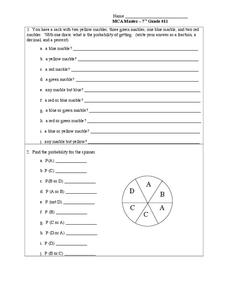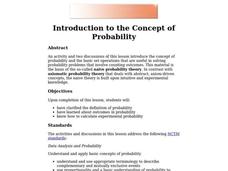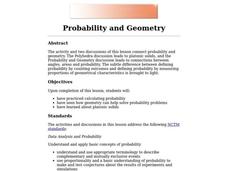Curated OER
Leveled Problem Solving: Introduction to Probability
In this probability worksheet, students solve 6 word problems where they determine the probability of certain outcomes that occur when spinning different spinners, rolling dice, choosing events and hitting targets.
Curated OER
Calculating Probabilities: Introduction
Introduce your class to a sure-fire method for calculating probabilities. The method is described alongside several examples, then put into practice with a series of probability questions for the class to solve. This would be a great...
Curated OER
Probability Fun
What are the chances? Probability comes into play in this worksheet as mathematicians examine a circular chart with images, determining the possibility that the "spinner" will land on each of the images. Appropriate for younger...
Curated OER
Probability
Seventh graders solve and complete 2 different problems that include a number of other possibilities. First, they draw a marble as stated for each out of a sack of marbles and determine the probability of getting that particular marble....
Curated OER
Introduction to the Concept of Probability
Middle and high schoolers have a clarified definition of probability, they explore about outcomes in probability and how to calculate experimental probability. They use computers to learn about probability.
Curated OER
Probability Experiment Simulation: Design and Data Analysis Using a Graphing Calculator
Seventh graders simulate probability experiments. Using a graphing calculator, 7th graders design, conduct, and draw conclusions from simulations or probability experiments. Students construct frequency tables and compare the...
Curated OER
Probability and Applications of Simulations
Middle schoolers apply properties of probability to the real world. In this probability lesson, learners simulate the construction of empirical distribution. They collect and analyze data using central tendencies.
Curated OER
Most Likely/Least Likely
Learners consider a practice problem which prompts them to choose the type of marble most likely to be picked out of a group. Then, they answer probability-type questions regarding a spinner, and a tally chart of coins.
Curated OER
Probability
Second graders experiment with probability. In this probability lesson, 2nd graders pick colored beans from a bag to find the chance of getting different colors. They make fair and unfair spinners and record the data after spinning...
Curated OER
Probability: Grade A
Math whizzes explore dependent and independent outcomes. They determine the outcome of simple and compound events. Pupils complete tree diagrams to identify outcomes. They identify fair and unfair games. This two-page learning exercise...
Shodor Education Foundation
Introduction to the Concept of Probability
Acquaint mathematicians to the concept of probability with a discussion about the results of a game. Then have them play a dice, card, spinner, or coin game and recording the number of wins vs. the number of tries on an interactive web...
EngageNY
Chance Experiments
Class members are introduced to probability using terms such as impossible, unlikely, likely, and certain. Numbers between zero and one are associated with the descriptions of probability. Pupils find the likelihood of chance experiments...
Curated OER
Probability of Childhood Games
Middle schoolers explore the concept of probability. In this probability lesson, students find the probability of certain situations including spinning a spinner, drawing marbles from a bag, and rolling a dice.
Curated OER
Spinning Probability
Sixth graders study the concept of probability. In this probability lesson, 6th graders create spinners that match specific sets of clues. Students use their spinners and worksheets to explore and predict probability.
Curated OER
Probability
In this probability and statistics learning exercise, students determine the probability of a series of independent event occurring. The one page learning exercise contains a combination of four multiple choice and free response...
Curated OER
Probability
In this probability learning exercise, students write answers as fractions. In this short answer learning exercise, students solve nine problems.
Curated OER
Data Management and Probability: Applications
In this data management and probability applications worksheet, 8th graders solve 20 various types of probability problems. They find the mean, median, mode and range of various numbers. Then, students use the spinner illustration to...
Curated OER
Probability and Geometry
Students explore the ways Geometry can help solve probability problems. Students describe platonic solids and practice calculating probability using an online resource. They construct dice with various numbers of sides to demonstrate...
Curated OER
Probability
Students explore probability. For this probability lesson, students define theoretical probability and experimental probability. Students predict outcomes of hands on activities using coins and colored tiles, complete a chart...
Curated OER
Ideas That Lead to Probability
Students explore and define the concept of probability. They utilize a random number generator to determine the fairness of a game. Internet and printable versions fo the activities are included.
Curated OER
Calculating Theoretical & Experimental Probability
Students collect data by conducting a survey of fellow classmates. They investigate the relationship between estimates obtained from samples and theoretical probabilities. Answer keys included.
Curated OER
Probability- Two Events
In this statistics worksheet, students examine different events after translating the word problems into equations and choose which event is most likely to occur. There are 14 questions with an answer key.
Curated OER
Probability Concepts (Practice 20.2)
In this probability worksheet, students solve 16 problems pertaining to probability and likely, less likely, certain and impossible outcomes.
Curated OER
Probability: Likelihood and Chance
A presentation demonstrates the basics of probability. Learners consider a variety of scenarios with dice, as well as picking certain-colored balls out of a bag in order to become familiar with this concept. The PowerPoint is brief, but...























